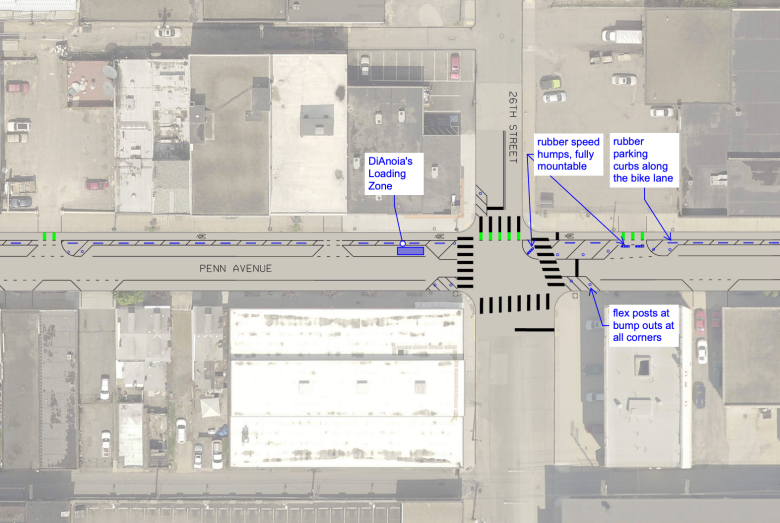
Some of yinz really hate bike lanes, huh? That’s a clear takeaway from the lawsuit and subsequent injunction currently stalling the construction of a protected bike lane along Penn Avenue between 22nd and 31st streets. The business owners say their complaint is about “Preserv[ing] the Strip” and preventing the city from “devastating our historic community” — as if replacing a lane for cars with one for bikes would mean, I don’t know, knocking down one of the neighborhood’s landmarks to make way for new development.
The ongoing NIMBY fight against bike lanes seems based on the expectation that reducing lanes causes congestion, an idea contradicted by the phenomenon of induced demand. The Strip District Business Association also has a host of other worries that range from somewhat reasonable to hyperbolic.
Before addressing these claims point by point, I want to say that my overarching impression here is that these business owners must believe that 1) the only “normal” way to navigate the Strip is with a car, and 2) Pittsburghers who walk, roll, or bus to the Strip aren’t their preferred customers. I can’t help but feel that these businesses must see themselves more as catering to well-heeled out-of-towners (or nearby condo residents) than longtime local residents. Read into that what you will.
But as a bicycle commuter who regularly spends money in the Strip, I find the idea that a bike lane will lead to “Frustrated Visitors that will not Return [and] Devastation for Local Business” absurd. Parking in the Strip is already a nightmare, and that certainly hasn’t stopped business from booming along Penn and Smallman, nor has it prevented a steep increase in people moving to the neighborhood.
As to the Business Association’s more concrete claims, let’s review:
- Increased Traffic Congestion & Backups: Per the federal DOT, “Studies have found that roadways did not experience an increase in crashes or congestion when travel lane widths were decreased to add a bicycle lane.” Numerous other studies corroborate these findings. Next!
- Impede Emergency Vehicles: As designed, the bike lane would be protected by rubber speed humps (“fully mountable”!), parking curbs, and flex posts. It’s not as though the planned lane would be walled off by actual bollards — emergency vehicles, as needed, could roll over these low rubber barriers. This is a problem other cities solved long ago.
- Hindrance for Residents: Do Strip residents not ride bikes? What?
- Unworkable Loading Zones/Delivery & Pickup Delays and Interruptions: Beyond the fact that the Penn Avenue Rightsizing plan includes multiple loading zones along Penn itself, the entire stretch of Penn from 22nd to 31st streets features parallel alleyways on both sides behind all of the businesses along this corridor where shipments could be delivered.

- Unsuitable Turning Radii for Emergency Vehicles & Larger Trucks: Since this entire project was designed by professionals, and the curb bumpouts at intersections are only protected by FlexPosts, which are easy enough to just run over, this claim seems like a difficult one to prove.
- Cross Traffic Visibility will be Obstructed. Vehicles will have to Intrude into Bike Lane: They’ll “have to”? That’s illegal! Also, having a bike lane, if anything, would make traffic at intersections easier to see than it currently is. I can say anecdotally that I’ve seen and almost been in fender benders on Penn caused by drivers pulling out into intersections to look for oncoming traffic.
- And, of course, Economic Loss for the Community. Once again, do these folks assume bicyclists don’t spend money? Even, say, at a friendly bike shop located directly on Penn? I don’t buy it.
In a neighborhood rapidly shifting from a small, outsider-oriented business district surrounded by industry to one that has storefronts opening and condos going up all the way to Lawrenceville, it’s especially difficult to understand the opposition. The Strip is becoming a complete neighborhood — it’s walkable, bikeable, and vibrant, if increasingly expensive. For recent tech grads or well-off retirees, it could be framed as the perfect place to move in Pittsburgh if you don’t own a car!
Beyond that, though, car ownership is falling, e-bike sales are booming, and older adults with disposable income have shown an increasing predilection for ditching four wheels for two. Ridership percentages are mostly stable across all income levels, and replacing a car parking spot with a bike rack can actually boost a business’s revenue by up to 78%.
If you build the bike lane, the cyclists will come — and the business won’t just survive, but benefit from people who see the neighborhood not just as a weekend shopping destination, but a place to live, work, and explore. I encourage these business owners to embrace the MAMILs and e-bike commuters and multimodal users who would love an easier, safer way down one of Pittsburgh’s most important thoroughfares. We can preserve the Strip District without remaining stuck in the past.
This article appears in Fall Guide 2025.





